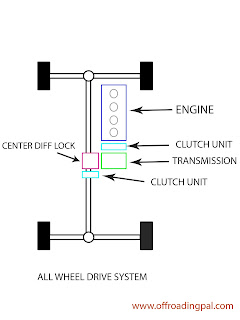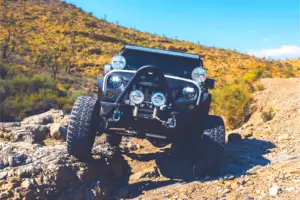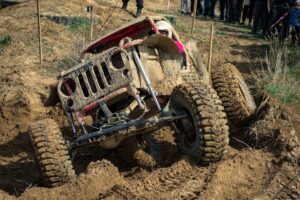Center differential lock gives you the ability to lock front and rear axles to divide the engine power (rotational force & rotational speed) equally between both front and rear wheels.
This may bit confusing to you. But don’t worry. I’ll explain in simplest form, why these things are important and when to use them. In this guide I’m going to talk about a general mechanism to keep things simple and understandable.
There are improved technologies out there by different vehicle manufacturers based on these general mechanisms. Understanding the basic principles is the most important step in the path of learning advance concepts. So let’s begin with basics.
Contents
What is the purpose of a normal rear differential?
Think of a car running straight on a highway. If all the wheels are straightly rotating, the rotation speed of all 4 wheels are the same.
But when it is cornering(taking a bend) things get changed. 4 wheels take 4 different paths. You can see that in the below video.
What does that mean? It means 4 wheels travel 4 slightly different distances in a unit of time. Simply it means rotational speed of the wheels are different.
Let’s take only the rear 2 wheels. The wheel in the inner side(near to the center of the arc) of the bend should spin slower than the outer wheel. Otherwise cars cannot take the bend.
How do this wheel speed difference achieved by a car ? By its differential that locates the middle of two rear wheels.
So the purpose of the differential is to spin the two wheels at different speeds when needed.
It is done by a mechanism in the differential that is done by a gear wheels system and three shafts.
I’m not going to talk about the mechanism deeply right here. But you can understand the mechanism from the below video.
So what is a differential lock ?
Simply differential lock is kind of a lock that stops the normal mechanism of a differential and allows both right and left wheels to spin at the same speed.
What is the difference between 4wd and AWD?
To explain this simply, I had drawn the following simple diagram.


According to the diagrams, both AWD and 4WD transfer power from engine to transmission unit through clutch or torque converter depending on if it is a manual or auto transmission.
Then the difference happens. In AWD there’s a center differential. Through that power transfer to the front and rear differentials and through those differential, all four wheels.
There’s another clutch between center differential and rear differential to transfer more torque to that direction when needed.
But it’s not much important for our discussion right now.
But in 4wd there’s a transfer case. Transfer case is the unit that divides the power of the engine to front and rear wheels 50/50, when you engage in 4 wheel drive mode.
When four wheel mode is switched off it transfers the engine power 100% to the rear wheels.
Through transfer case power goes to the front and rear differentials and then all four wheels.
Those are the difference of mechanisms in AWD and 4WD systems.
What is the purpose of a central differential lock ?
This central differential lock also does the same job as normal differential locks.
It locks the normal differential mechanism and allows power to divide equally for both front and rear axles.
What’s the importance of this? Let’s take an example.
When will the central differential lock be used ?
Think both front wheels of an AWD vehicle stuck on snow and rear wheels are on the hard pavement.
If the center differential disengages and tries to reverse the vehicle, to take out what happens.
Open center differential of the AWD vehicles always tries to send the power into the wheel that can easily spin.
In this scenario it’s front differentials. It sends all the power to the front wheels and front wheels spin continuously.
No spin in rear wheels. Vehicle doesn’t move an inch.
Then the center differential lock engaged and again tried to reverse . Then what happens. Center diff is now locked.
So that power is equally divided and transferred to both front and rear differentials.
Front wheels are still spins but rear wheels on the rough pavement do the job. Vehicle can take out of the stucked place.
But please keep in mind this is just an example to explain this. But modern AWD vehicles come with computer units and traction control systems.
They manage to transfer engine torque to the wheels which have most traction. If you are curious to know whether center diff-lock or front and rear diff locks best for off-roading you can read this guide.
In 4wd vehicles
In 4wd vehicles when you switch on 4wd mode it simply works like a center differential locking from the transfer case.
That means as I mentioned previously the transfer case divides the engine power 50/50 to front and rear similar to the instance, AWD in center diff lock on.
I think you got the point right now.
Important things to know when engaging in 4wd mode.
As far now you know how things are going on. So think about an instance of a 4wd drive vehicle engaged in 4wd mode on a highway. What can happen.
Let’s go to the start. As I mentioned when a car taking a bend 4 wheels spin at 4 different speeds.
If 4 wheel mode is on that means the transfer case tries to spin both front and rear shafts at the same speed.
But it can’t happen when cornering. In that case it causes damage to the transfer case, gears and drive shafts.
That’s why it’s advised to engage in 4wd mode only when it is needed like off-roading. On highways you can engage in 4wd mode if it’s really needed but at somewhat slow speeds.
But the best advice is, not to use them on highways.
Do you know that switching from 4hi to 4low while driving is safe or not? You can know about that by clicking here.
But now there are new vehicles that can drive on highways in highspeed with adding changes to the above general mechanism.
As an example, adding a clutch system(viscous coupling) between the transfer case and rear differential solves the problem. It gives ability to rotate front and rear axles of drivetrain in different speeds when needed.
Do you think traction control system of your vehicle helps you when wheeling in mud? I wrote a separate article about that.
If you interest to know that you can read that also. To read that click here.
So things are changing fast. But the basic mechanisms should be there in your mind to understand those things.
So I think I had covered all the things I mentioned at the start.
If you think this article may be helpful for someone else, share this with them. You just have to hit a share button below.
Have fun and safe off-roading !!




Your comment is awaiting moderation.
Where can i purchase dapoxetine?[url=http://northwestpharmacycanadaprescriptions.com/]canadian pharm support group[/url][url=http://canadianpharmacyonline.ru/]trusted rx pharmacy[/url]Nizagara[url=http://healthymandrugs.com/]healthy man[/url]
Your comment is awaiting moderation.
Where can i buy cheap viagra[url=http://supremesuppliersindia.com/]supremesuppliers[/url][url=http://uuuppharmacy.com/]online pharmacy[/url]Groovorionorthwestpharmacydrugstore.com[url=http://northwestpharmacydrugstore.com/]canadian pharmacy cialis[/url]
Your comment is awaiting moderation.
Prednisolone[url=http://canadapharmacy24drugstore.com/]canadian pharmacy[/url][url=http://pharmwithoutaprescription.com/]canadian pharmacy no prescription[/url]Overnight cialis in us[url=http://healthymandrugs.com/]healthy man complaints[/url]
Your comment is awaiting moderation.
Inhouse pharmacy[url=http://northwestpharmacycanadaprescriptions.com/]canadian pharmacy online cialis[/url][url=http://vgronlinepharmacy.com/]canadian pharmacy online no script[/url]Generic levitra 20mg[url=http://woldwidewithoutaprescription.com/]canada pharmacy online no prescription[/url]
Your comment is awaiting moderation.
Canadian cialis[url=http://skyph.net/]skypharmacy[/url][url=http://canadianpharmacyonline.ru/]on line pharmacy[/url]Online parmacy[url=http://healthymandrugs.com/]healthy man viagra[/url]